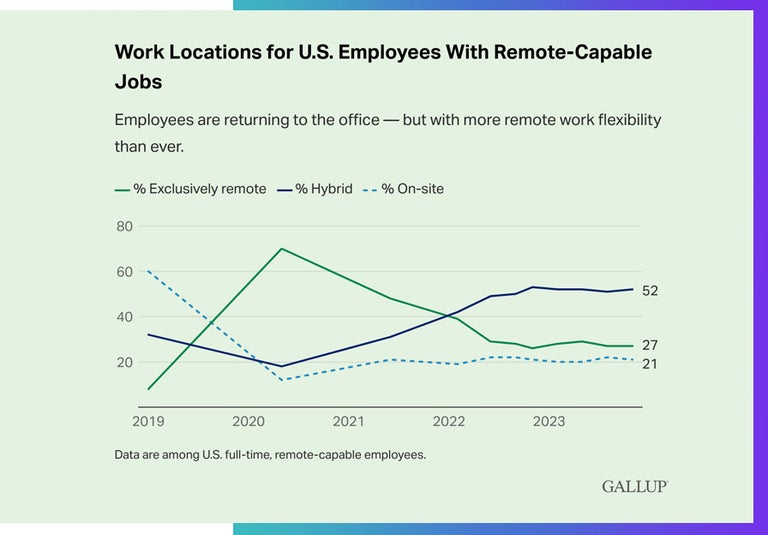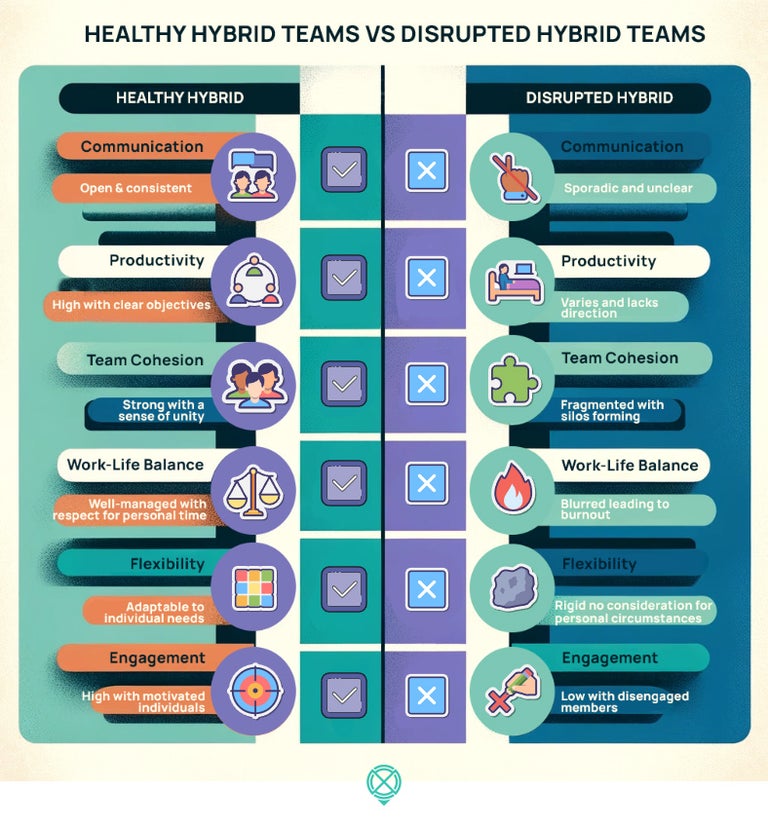Contents
- The Hybrid Work Trapdoor
- Hybrid Teams in a State of Disruption
- The Three Hybrid Flexibility Traps (And How to Fix Them)
- 1. The Hybrid Management Scaries
- 2. Invisible Work Creep
- 3. Performative Office Days
- Taking Action to Avoid Flexibility Disruption
Hybrid work can be a trapdoor disguised as flexibility for your team. These three management tactics will help you transform the hidden pitfalls of hybrid inflexibility into platforms for peak team performance.
The future of work is hybrid with 52% of folks working part-time from home.

It's clear hybrid work has surfaced as a popular choice for companies, even though the average worker still prefers to be fully remote. But a little remote is better than nothing, right?
Not if your hybrid model is inflexible.
Unpopular opinion: true flexibility rarely exists in hybrid work arrangements.
Despite this, US companies increased flexible work from 51% to 62% in 2023.
In the name of ‘going remote’ and the noble pursuit of work-life balance, managers are not simply choosing one or the other. We’re choosing both. It can be problematic for everyone.
Are hybrid managers accidentally making the average work week harder for their teams?
- 80% of HR execs say that hybrid work is exhausting their employees.
Individual worker experiences of hybrid work vary from one extreme to the other. These experiences are directly related to how you execute your hybrid work model and manage your team.
- Healthy Hybrid: Taps into the benefits of flexible work for individuals and the company.
- Disruptive Hybrid: Damages or obstructs your remote team’s ability to perform at their best, while prioritizing benefits for the company.
Let’s explore how hybrid work can disrupt team flexibility and what you can do to make sure that your remote teams are benefitting from flexibility, instead of being sabotaged by it.
The Hybrid Work Trapdoor
Hybrid work is prone to something called ‘the trapdoor effect.’
Imagine a castle, modern on the surface, but beneath its polished floors are ancient trapdoors.
These were designed for swift passage, but now they lead to confusing dead ends or meander on forever.
This castle mirrors hybrid work models that promise unparalleled flexibility and efficiency, blending old and new ways to work.
But these trapdoors have been neglected, and they become pitfalls - turning shortcuts into literal traps.
The trapdoor effect in hybrid work is this very paradox. It’s a façade of adaptability that without careful cultivation, ensnares your team in a web of bygone inefficiencies.
It makes the quest for seamless productivity an intricate dance around hidden snares.
The goal of course, is to be aware of the traps – and take action to avoid them.

Hybrid Teams in a State of Disruption
Before we crack into the three management tactics that will help you avoid the hybrid work trap, it helps to be able to assess if your team is in a state of disruption.
Use the chart below to find out:

Some red flag phrases you might hear:
- “I don’t know when any of this is due.”
- “I work so much but nothing ever gets done.”
- “I never have time for personal stuff anymore.”
- “I miss half the updates since we switched.”
- “It doesn’t matter anymore, just get it done.”
The Three Hybrid Flexibility Traps (And How to Fix Them)
There are three main hybrid work flexibility traps that you need to avoid, as someone interested in optimizing your hybrid team environment.
Eliminating these gives you a huge head-start when building a hybrid culture that genuinely profits from remote work.
1. The Hybrid Management Scaries
AKA: Bad managers who enforce rigid ill-fitting schedules.
Working remotely requires ruthless prioritization and near godlike management skills. Peer reviewed papers prove remote work creates communication silos, so managers have to be well-trained.
But what if your hybrid manager doesn’t know much about remote work? Or worse, what if they don’t see the difference between in-person management and management from home?
These managers rigidly set the team’s hybrid schedule, disregarding the unique working styles, life commitments and productivity cycles of the team.
A one-size-fits all hybrid mandate is harmful to flexibility. It effectively erases the benefits of hybrid work for the individual. You don’t get to choose when you work, or where, or how.
That’s all been chosen for you, usually by a manager who lacks the skill, vision or aptitude to be remotely collaborative.
Worse still, hybrid becomes an illusion of choice – a fake autonomy that is entirely one-sided.
The company gets to save a buck, but the teams sent home a couple times a week are poorly managed, and can’t do their best work.
- A FlexOS report says employees rate their hybrid managers a mediocre 7/10.
- Only half of all professionals understand their company’s hybrid work plan.
Bad managers drag their poor management practices into the virtual space, and it robs their teams of the many proven benefits of flexible working.
Nothing kills a remote team faster than a rigid manager who tries to control people when they’re not at the office.

If your team dreads hybrid days, then they’ve got the hybrid management scaries.
It’s exactly like the Sunday scaries, only the dread comes from the general chaos of trying to cope with bad management when you work from home.
Empower with Autonomy: Let your workers tailor their schedules for peak productivity. Upskill your management ability and let go of authoritarian practices that don’t serve anyone.
2. Invisible Work Creep
AKA: Ignoring the invisible work of flexibility.
I bet you’ve heard a lot about how flexible work lets employees work more during the hours they’re most productive. It can amount to 16.8 more days a year than strictly office work!
But what happens when the expectation of increased productivity is in place, without acknowledging the invisible work flexibility adds to your team schedule?
Let me ask you this:
- How much time do you spend planning and organizing hybrid days?
- Do you work late to upload documents to databases and storage systems?
- How much time do you spend on emails, meeting notes and text messaging?
- When do you troubleshoot, prepare, sort or clear activities to support ‘real’ work?
A groundbreaking study by the British Sociological Association found that there is an increasing (and somewhat devastating) link between what is considered ‘real’ work and the growing demands of invisible digital work.
‘Digi-housekeeping’ as they call it, is the work required to maintain the digital tools that support flexible working arrangements. This type of work is incredibly time-consuming and often devalued to the point of dismissal.

It involves clearing, sorting, preparing, provisioning and troubleshooting data for teams and shared virtual work environments.
In poorly managed hybrid models this displacement of work onto the individual leaves teams frustrated, constantly behind and burnt out.
Those feelings of ‘work is suddenly more intense’ are valid. It is!
Good managers make allowance for invisible work creep and the REAL demands of a functional hybrid model. Instead of dismissing this work, it’s deemed valuable.
- Adjusting important deadlines to meet team needs
- Including digital housekeeping time as authentic work time (and included in pay)
- Understanding what digi-housekeeping tasks are (and streamlining them)
- Rigidly enforcing digital downtime to limit overwork and overwhelm
Spotlight Digital Housekeeping: Give your team's time to adjust and find ways to easily integrate these time-consuming practices into their hybrid schedules.
3. Performative Office Days
AKA: Dismissing valid checks and balances for higher performing remote workers.
If hybrid work is truly about dialing into the benefits of flexibility, then it stands to reason that some employees will naturally work better from home.
Identifying them, and allowing them to do that can be incredibly difficult for bureaucratic hybrid managers.
Performative work or productivity theater happens when remote workers are made to come into the office, even though they are significantly less productive there.

And this stems from a lack of checks and balances, and from an inability to measure and recognize the success of individuals within your team. Some may thrive with three days in office, and two at home.
Some may only need to check into the office once a month.
Great hybrid teams do not support performative office days. The days they are in-office are filled with purpose, and are usually used for strengthening social bonds.
“What gets measured, gets managed,” as they say.
Do you know how to measure the success of your hybrid team? Only 22% of organizations establish metrics to quantify productivity improvements from hybrid work.
Here are some key metrics:
- Employee satisfaction
- Employee retention
- Employee motivation
- Employee productivity / output
- Employee sick days
When you measure these in relation to a benchmark from office work, you create the opportunity to see whether hybrid work or fully remote work is best for your team, down to the individuals you manage.
Often, you’ll find that true productivity will come when workers are where they should be.
Embrace Checks & Balances: Know how to measure the success of your hybrid team. And don’t be afraid to minimize performative office days for the team members who endure them.
Taking Action to Avoid Flexibility Disruption
Is hybrid work disrupting or inspiring your team?
It’s clear that the allure of flexibility can sometimes lead us way off course – through hidden trapdoors of inefficiency and disconnection.
As you manage your hybrid team, remember the trapdoor effect and how it might impact your workers.
Hybrid work was designed for increased flexibility, but it can have the opposite effect – leading to unforeseen challenges that lurk just beneath the surface, wrecking team dynamics.
You know the signs of a disrupted team, now look out for them.
These are the traps you must avoid!
Use the three management tactics I’ve spoken about here to turn potential traps into opportunities for success.
With strong hybrid management practices, the acknowledgment of invisible work and the confidence to eliminate performative office days – you will succeed.
Don’t let hybrid work become a trapdoor that robs your team of true flexibility.
Steer them through the remote work labyrinth with vigilance and vision, and turn those trapdoors of disruption into gateways of unparalleled growth and connectivity for everyone.









